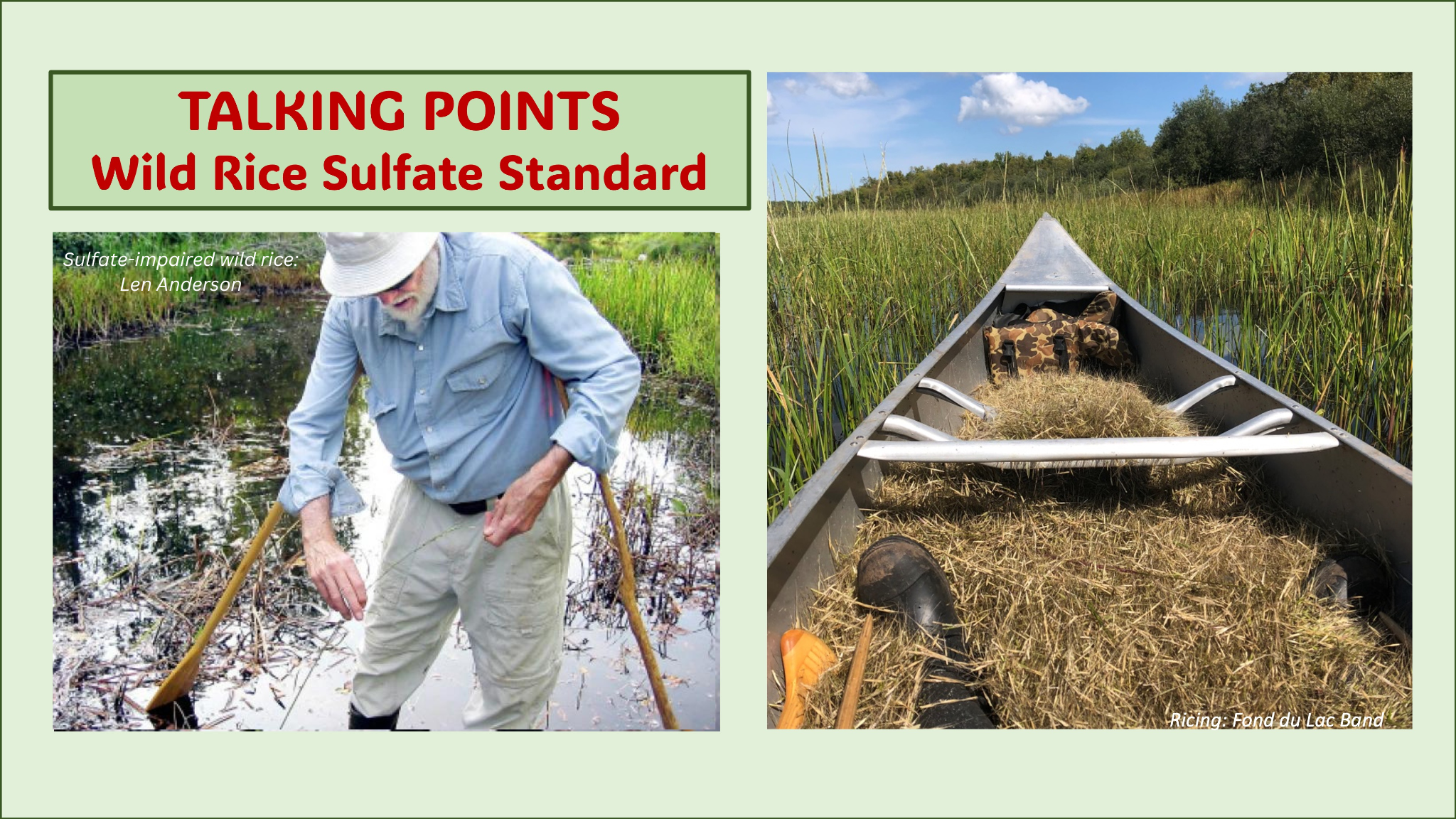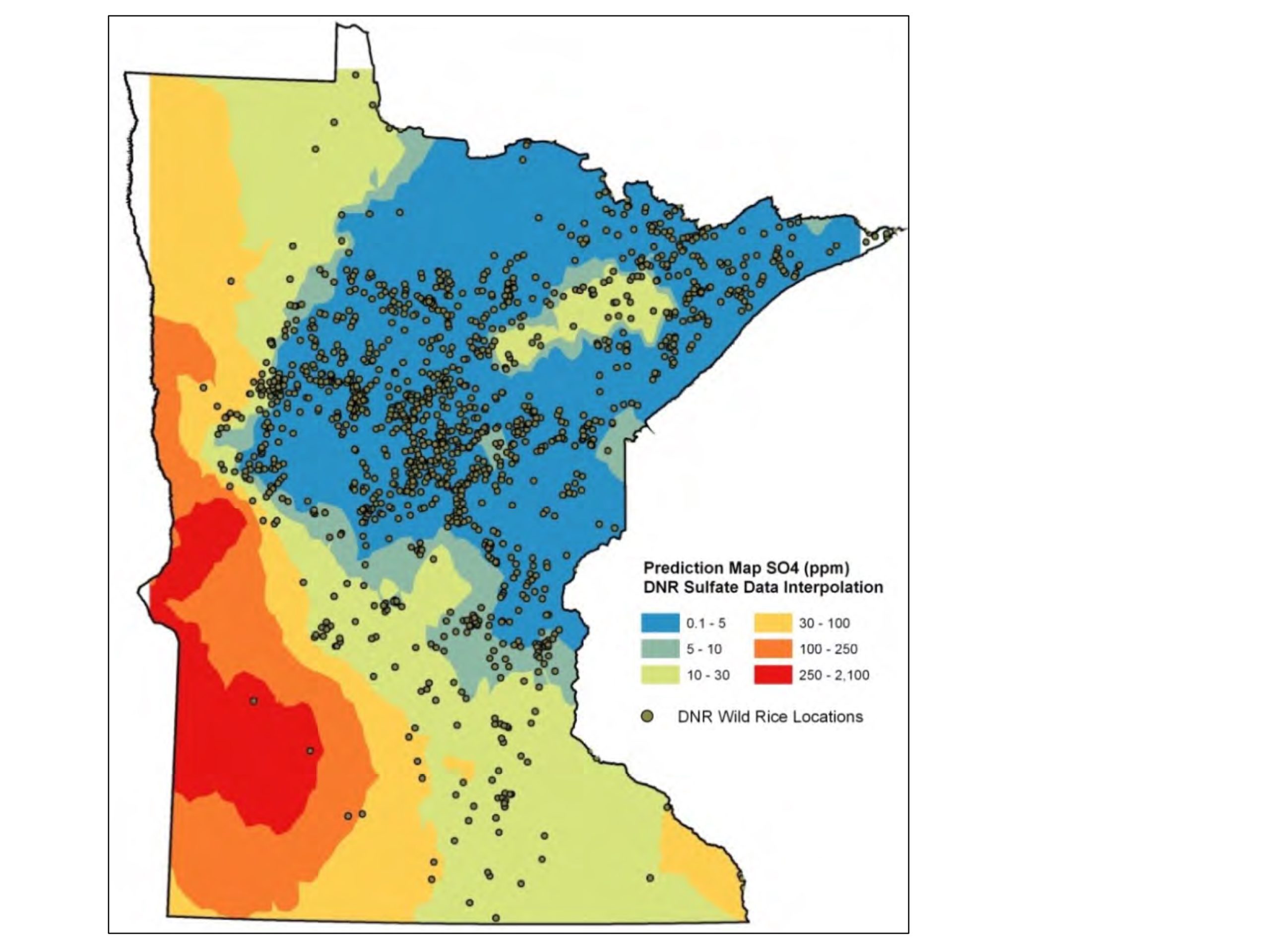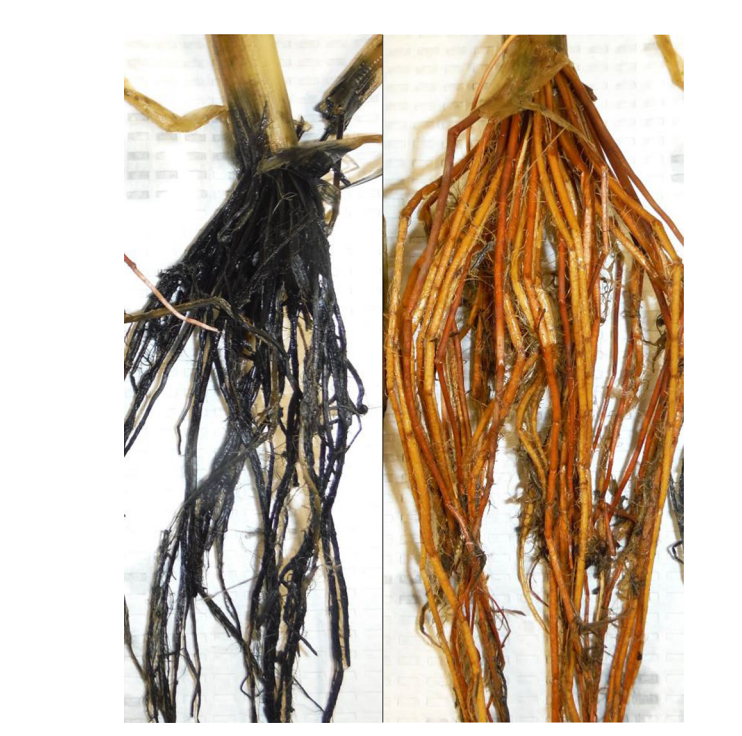MPCA Wild Rice Sulfate Standard Permitting Plan & “Site-Specific Standards”

MPCA Comment Deadline: September 4, 2023 11:59 pm
MPCA Information Meeting: September 27, 2023 1-2:00 pm
MPCA is NOT planning any public hearing in addition to written comments.
The Minnesota Pollution Control Agency (MPCA) has resisted enforcement of Minnesota’s 1973 federally-approved wild rice sulfate standard for 50 years. However, due to advocacy by WaterLegacy and tribes, state courts have recently upheld Minnesota’s 10 parts per million (ppm) wild rice sulfate standard and the U.S. Environmental Protection Agency (EPA) has required MPCA to list Minnesota wild rice waters impaired because sulfate exceeds the standard.
MPCA is now proposing an implementation plan for permitting that would allow low-sulfate waters to be degraded. Lakes and streams where wild rice grows abundantly in the Boundary Waters, Lake Superior watershed, and north central Minnesota often have natural sulfate levels far below 10 ppm. [see map below] MPCA proposes that permits in low-sulfate areas will only limit sulfate if a discharger’s pollution would increase sulfate levels to more than 10 ppm. Allowing degradation may harm wild rice abundance as well increasing mercury contamination of fish and opening the door to future violations of the sulfate standard.
Two taconite mining companies have requested “site specific standards,” to allow more sulfate pollution, and MPCA on its own can also propose a “site specific standard” to allow elevated sulfate levels to continue. MPCA has proposed that a polluter would have to show that wild rice long-term beneficial use would be protected to get an exception, but criteria for this proof are unclear. MPCA has also proposed allowing more sulfate pollution where there are high levels of iron, the very approach rejected in MPCA’s failed 2018 rulemaking. When sulfate is added to waters and sediments that are high in iron, iron sulfide plaques form on wild rice roots and impair seed production. [see image below].
Please feel free to copy or edit the Talking Points below in sending comments to MPCA.
Talking Points
- Must enforce standard. MPCA must enforce Minnesota’s wild rice sulfate standard of 10 parts per million (ppm) under the Clean Water Act and decisions of the Minnesota courts. MPCA has no discretion to continue to delay or deny enforcement. The 10 ppm sulfate standard is the “effects threshold” for wild rice impairment.
- Degradation prohibited. Both the Clean Water Act and Minnesota law prohibit degradation of water quality in Minnesota lakes, streams, and wetlands. MPCA must not allow polluters to degrade high quality, low-sulfate wild rice waters.
- Protect low-sulfate waters. Many of Minnesota’s most abundant wild rice stands in the Boundary Waters, the Lake Superior watershed, and north central Minnesota (including the Big Sandy Lake area) have far less than 10 ppm of sulfate. MPCA permitting should not allow sulfate in these wild rice waters to increase even if the degraded level of sulfate remains just below the standard.
- Sulfate and mercury. Sulfate pollution increases toxic mercury contamination of fish due to release of mercury from sediments and increased mercury methylation. MPCA must consider the effects of lax sulfate standard enforcement on mercury and methylmercury.
- Health threat of sulfate and mercury. MPCA lax enforcement of the wild rice sulfate standard and increased mercury contamination of fish will damage the developing brains of fetuses, infants, children, and people who rely on fish for subsistence, and will impair the exercise of tribal Treaty-reserved rights.
- Need proof to consider “site-specific standard.” The wild rice sulfate standard is not advisory. Any discharger asking for MPCA even to consider of a “site-specific standard” sulfate standard must prove that wild rice beneficial use will be protected long-term.
- High iron does not protect wild rice. Peer-reviewed scientific evidence does not support allowing more sulfate when there is also a high level of iron in sediments. Adding sulfate to waterbodies with high levels of iron coats wild rice roots with iron sulfide and interferes with wild rice seed quality, production, and sustainability.
- MPCA’s “equation” is not valid science. MPCA’s “equation” method to determine if wild rice production would be protected without the 10 ppm standard was debunked in contested case proceedings in 2018. The “site-specific standards” loophole should not be used to resurrect this scientifically unsupported theory.
- Current discharge – historic proof. Before a “site-specific standard” can be considered for wild rice waters that currently exceed the wild rice sulfate discharger, the proponent (discharger or MPCA) should have to prove based on independent research––from the time historic sulfate discharge began to the present––the absence of harm to wild rice beneficial use, including harm to wild rice abundance, seed productivity, genetic diversity, and nutritional quality.
- New or expanded discharge – research required. Before a “site-specific standard” can be considered for a new or expanding discharge to wild rice waters, the proponent (discharger or MPCA) should have to prove based on at least 5 years of independent research using site-specific wild rice seeds and sediment that the proposed sulfate levels would not cause harm to wild rice beneficial use, including harm to wild rice abundance, seed productivity, genetic diversity, and nutritional quality
- Tribal and public process. No “site-specific standard” for discharge of sulfate to wild rice should be approved by MPCA without tribal consultation and tribal consent and a formal and public rulemaking process.
- Enforcement without further delay. Unless and until a “site-specific standard” has been formally approved as required under state law and the Clean Water Act, the MPCA must apply the 10 ppm wild rice sulfate standard in setting and enforcing permit limits and in preparing TMDL studies and implementation plans to restore wild rice waters listed as impaired due to excessive sulfate. MPCA must neither delay or assume a less stringent will at some point be approved.
Wild Rice Locations and Sulfate Concentrations Map (MPCA & DNR Data)

Scientific Research Image from S. LaFond-Hudson, Iron sulfide formation on root surfaces controlled by the life cycle of wild rice, Biogeochem. (2018)

Abstract: “We exposed a model annual wetland plant, Zizania palustris [wild rice], to elevated sulfate concentrations (3.1 mM) and quantified the development of iron oxide and iron sulfide precipitates on root surfaces throughout the plant life cycle. During the onset of seed production, root surfaces amended with sulfate transitioned within 1 week from iron (hydr)oxide plaques to iron sulfide plaques . . . Sulfate-amended plants produced fewer and lighter seeds with less nitrogen than unamended plants.”
